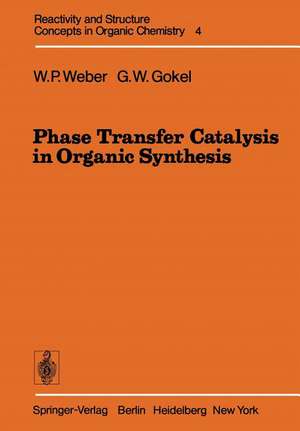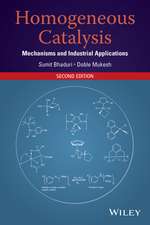Phase Transfer Catalysis in Organic Synthesis: Reactivity and Structure: Concepts in Organic Chemistry, cartea 4
Autor William P. Weber, George W. Gokelen Limba Engleză Paperback – 8 mar 2012
Din seria Reactivity and Structure: Concepts in Organic Chemistry
- 15%
 Preț: 637.93 lei
Preț: 637.93 lei - 15%
 Preț: 638.57 lei
Preț: 638.57 lei -
 Preț: 402.76 lei
Preț: 402.76 lei -
 Preț: 388.13 lei
Preț: 388.13 lei - 15%
 Preț: 650.19 lei
Preț: 650.19 lei -
 Preț: 400.65 lei
Preț: 400.65 lei - 18%
 Preț: 721.63 lei
Preț: 721.63 lei -
 Preț: 378.71 lei
Preț: 378.71 lei -
 Preț: 378.71 lei
Preț: 378.71 lei - 15%
 Preț: 641.53 lei
Preț: 641.53 lei -
 Preț: 380.84 lei
Preț: 380.84 lei - 15%
 Preț: 636.45 lei
Preț: 636.45 lei - 15%
 Preț: 650.37 lei
Preț: 650.37 lei - 15%
 Preț: 640.08 lei
Preț: 640.08 lei -
 Preț: 387.75 lei
Preț: 387.75 lei - 15%
 Preț: 640.06 lei
Preț: 640.06 lei -
 Preț: 387.20 lei
Preț: 387.20 lei -
 Preț: 380.84 lei
Preț: 380.84 lei - 15%
 Preț: 639.08 lei
Preț: 639.08 lei - 15%
 Preț: 639.08 lei
Preț: 639.08 lei -
 Preț: 381.81 lei
Preț: 381.81 lei -
 Preț: 382.57 lei
Preț: 382.57 lei -
 Preț: 395.25 lei
Preț: 395.25 lei - 15%
 Preț: 643.34 lei
Preț: 643.34 lei -
 Preț: 378.54 lei
Preț: 378.54 lei - 15%
 Preț: 636.45 lei
Preț: 636.45 lei - 20%
 Preț: 546.17 lei
Preț: 546.17 lei - 15%
 Preț: 638.43 lei
Preț: 638.43 lei
Preț: 642.83 lei
Preț vechi: 756.27 lei
-15% Nou
Puncte Express: 964
Preț estimativ în valută:
123.01€ • 129.02$ • 102.40£
123.01€ • 129.02$ • 102.40£
Carte tipărită la comandă
Livrare economică 01-15 aprilie
Preluare comenzi: 021 569.72.76
Specificații
ISBN-13: 9783642463594
ISBN-10: 3642463592
Pagini: 304
Ilustrații: XVI, 282 p.
Dimensiuni: 170 x 244 x 16 mm
Greutate: 0.49 kg
Ediția:Softcover reprint of the original 1st ed. 1977
Editura: Springer Berlin, Heidelberg
Colecția Springer
Seria Reactivity and Structure: Concepts in Organic Chemistry
Locul publicării:Berlin, Heidelberg, Germany
ISBN-10: 3642463592
Pagini: 304
Ilustrații: XVI, 282 p.
Dimensiuni: 170 x 244 x 16 mm
Greutate: 0.49 kg
Ediția:Softcover reprint of the original 1st ed. 1977
Editura: Springer Berlin, Heidelberg
Colecția Springer
Seria Reactivity and Structure: Concepts in Organic Chemistry
Locul publicării:Berlin, Heidelberg, Germany
Public țintă
ResearchCuprins
1. Introduction and Principles.- 1.1 Introduction.- 1.2 Early Examples.- 1.3 The Coalescence of Ideas.- 1.4 The Principle of Phase Transfer Catalysis.- 1.5 Evidence for the Mechanism of Phase Transfer Catalysis.- 1.6 Charged Catalysts: Quaternary Ions.- 1.7 Uncharged Catalysts: The Amines.- 1.8 Uncharged Catalysts: The Crown Ethers.- 1.9 Uncharged Catalysts: The Cryptands.- 1.10 Catalyst Comparisons.- 1.11 Solvents.- 1.12 The Role of Water in Phase Transfer Catalysis.- 1.13 Summary.- References.- 2. The Reaction of Dichlorocarbene With Olefins.- 2.1 Introduction.- 2.2 The Mechanism of the Dichlorocyclopropanation Reaction.- 2.3 Catalytic Cyclopropanation.- 2.4 Dichlorocyclopropanation of Simple Olefins.- 2.5 Cyclopropanation of Enamines.- 2.6 Dichlorocyclopropanation Followed by Rearrangement.- 2.7 Carbene Addition to Indoles.- 2.8 Carbene Addition to Furans and Thiophenes.- 2.9 Carbene Addition to Polycyclic Aromatics.- 2.10 Carbene Addition to Conjugated Olefins.- 2.11 Michael Addition of the Trichloromethyl Anion.- 2.12 Dichlorocarbene Addition to Allylic Alcohols: A Cyclopentenone Synthon.- 2.13 Dichlorocarbene to Phenols: Reimer-Tiemann Reactions.- References.- 3. Reactions of Dichlorocarbene With Non-Olefinic Substrates.- 3.1 Introduction.- 3.2 C — H Insertion Reactions.- 3.3 Reaction With Alcohols: Synthesis of Chlorides.- 3.4 Carbene Addition to Imines.- 3.5 Addition to Primary Amines: Synthesis of Isonitriles...- 3.6 Reaction With Hydrazine, Secondary, and Tertiary Amines.- 3.7 Dehydration With Dichlorocarbene.- 3.8 Miscellaneous Reactions of Dichlorocarbene.- References.- 4. Dibromocarbene and Other Carbenes.- 4.1 Introduction.- 4.2 Dibromocarbene Addition to Simple Olefins.- 4.3 Dibromocarbene Addition to Strained Alkenes.- 4.4 Dibromocarbene Addition toIndoles.- 4.5 Dibromocarbene Addition to Michael Acceptors.- 4.6 Other Reactions of Dibromocarbene.- 4.7 Other Halocarbenes.- 4.8 Phenylthio- and Phenylthio(chloro)carbene.- 4.9 Unsaturated Carbenes.- References.- 5. Synthesis of Ethers.- 5.1 Introduction.- 5.2 Mixed Ethers: The Mechanism.- 5.3 Rate Enhancement in the Williamson Reaction.- 5.4 Methylation.- 5.5 Phenyl Ethers.- 5.6 Methoxymethyl Ethers of Phenol.- 5.7 Diethers From Dihalomethanes.- 5.8 The Koenigs-Knorr Reaction.- 5.9 Epoxides.- References.- 6. Synthesis of Esters.- 6.1 Introduction.- 6.2 Tertiary Amines and Quaternary Ammonium Salts.- 6.3 Noncatalytic Esterification in the Presence of Ammonium Salts.- 6.4 Polycarbonate Formation.- 6.5 Crown Catalyzed Esterification.- 6.6 Crown Catalyzed Phenacyl Ester Synthesis.- 6.7 Crown Catalyzed Esterification of BOC-Amino Acid to Chloromethylated Resins.- 6.8 Cryptate and Resin Catalyzed Esterifications.- 6.9 Synthesis of Sulfonate and Phosphate Esters by PTC.- References.- 7. Reactions of Cyanide Ion.- 7.1 Introduction.- 7.2 The Mechanism and General Features of the Cyanide Displacement Reaction.- 7.3 The Formation of Alkyl Cyanides.- 7.4 Formation of Acyl Nitriles.- 7.5 Synthesis of Cyanoformates.- 7.6 Cyanohydrin Formation.- 7.7 The Benzoin Condensation.- 7.8 Hydrocyanation, Cyanosilylation, and Other Reactions.- References.- 8. Reactions of Superoxide Ions.- 8.1 Introduction.- 8.2 Reactions at Saturated Carbon.- 8.3 Additions to Carbonyl Groups.- 8.4 Reactions With Aryl Halides.- References.- 9. Reactions of Other Nucleophiles.- 9.1 Introduction.- 9.2 Halide Ions.- 9.3 Azide Ions.- 9.4 Nucleophile Induced Elimination Reactions.- 9.5 Nitrite Ion.- 9.6 Hydrolysis Reactions.- 9.7 Anionic Polymerization Initiation.- 9.8 Organometallic Systems.- 9.9 Isotopic Exchange.- References.- 10. Alkylation Reactions.- 10.1 Introduction.- 10.2 The Substances Alkylated.- 10.3 Phase Transfer Alkylating Agents.- 10.4 Alkylation of Reissert’s Compound.- References.- 11. Oxidation Reactions.- 11.1 Introduction.- 11.2 Permanganate Ion.- 11.3 Chromate Ion.- 11.4 Hypochlorite Ion.- 11.5 Catalytic Oxidation.- 11.6 Singlet Oxygen.- 11.7 Oxidation of Anions.- 11.8 Phosphorylation.- References.- 12. Reduction Techniques.- 12.1 Introduction.- 12.2 Borohydrides.- 12.3 Stoichiometric Reduction Systems.- 12.4 Other Catalytic Reductions.- 12.5 Altered Reactivity.- References.- 13. Preparation and Reactions of Sulfur Containing Substrates.- 13.1 Introduction.- 13.2 Preparation of Symmetrical Thioethers.- 13.3 Preparation of Mixed Sulfides.- 13.4 Preparation of Sulfides From Thiocyanates.- 13.5 Preparation of Alkylthiocyanates.- 13.6 Sulfides Resulting From Michael Additions.- 13.7 Synthesis of ?, ?-Unsaturated Sulfur Compounds.- 13.8 Other Phase Transfer Reactions of Sulfur Containing Substances.- References.- 14. Ylids.- 14.1 Introduction.- 14.2 Phase Transfer Wittig Reactions.- 14.3 The Wittig-Horner-Emmons Reaction.- 14.4 Sulfur Stabilized Ylids.- References.- 15. Altered Reactivity.- 15.1 Introduction.- 15.2 Cation Effects.- 15.3 Affected Anions.- 15.4 Ambident Nucleophiles.- References.- 16. Addendum: Recent Developments in Phase Transfer Catalysis.- Author Index.





